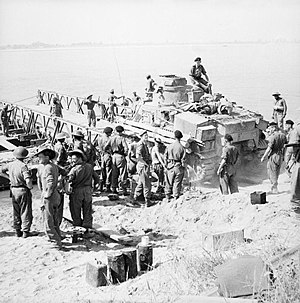Battle of Pokoku and Irrawaddy River operations
| Battle of Pakokku and Irrawaddy River | |||||||
|---|---|---|---|---|---|---|---|
| Part of Central Burma Campaign | |||||||
 A Lee tank loaded onto a pontoon ferry by British troops before crossing the Irrawaddy river at Ngazun, 28 February 1945. |
|||||||
|
|||||||
| Belligerents | |||||||
|
|
|||||||
| Commanders and leaders | |||||||
|
|
|
||||||
| Strength | |||||||
|
|
|
||||||
| Casualties and losses | |||||||
| ? | ? | ||||||
The Battle of Pakokku and Irrawaddy River operations were a series of battles fought between the British Indian Army and the Imperial Japanese Army and allied forces over the successful Allied Burma Campaign on the China Burma India Theater during World War II. The battles and operations were instrumental in facilitating the eventual capture of Rangoon in summer 1945.
The Japanese 31st Division's thrust at Kohima had been a costly failure, eventually forcing it to a disastrous retreat. The Japanese 33rd Division, Japanese 15th Division and the INA 1st Division had suffered a similar fate at Imphal. The Japanese and allied forces lost at least fifty thousand dead. In previous years there used to be lull during the monsoon period but not this year (1944–45). The command decided that it was time to target the heart of Japanese Army in Burma. General William "Bill" Slim's plan through the monsoon months had been pursuit of the defeated Japanese in Kohima and plains of Imphal with 5th Indian Infantry Division down the Tiddim Road and 11th East African Division down the Kabaw Valley, until the two joined hand at Kalemyo. The next offensive plan centred on the occupation of Central Burma, as far south as Mandalay to exploit further south and destroy the Japanese forces in the Shewbo Plains, north of Irrawaddy, where armour could be used. Allied forces crossed River Chindwin and the spearheads of both corps of the Fourteenth Army (IV and XXXIII Corps) were moving into selected battle areas, which surprised Japanese as they had not anticipated any major operations during the monsoon period. The British Fourteenth Army was now faced with a major obstacle (the Irrawaddy) covered by determined Japanese. The Irrawaddy River in its middle is about 2,000 yards (1,800 m) broad and dotted with treacherous and shifting sand bars. An opposed direct crossing would have been very expensive with low percentage of success.
...
Wikipedia
